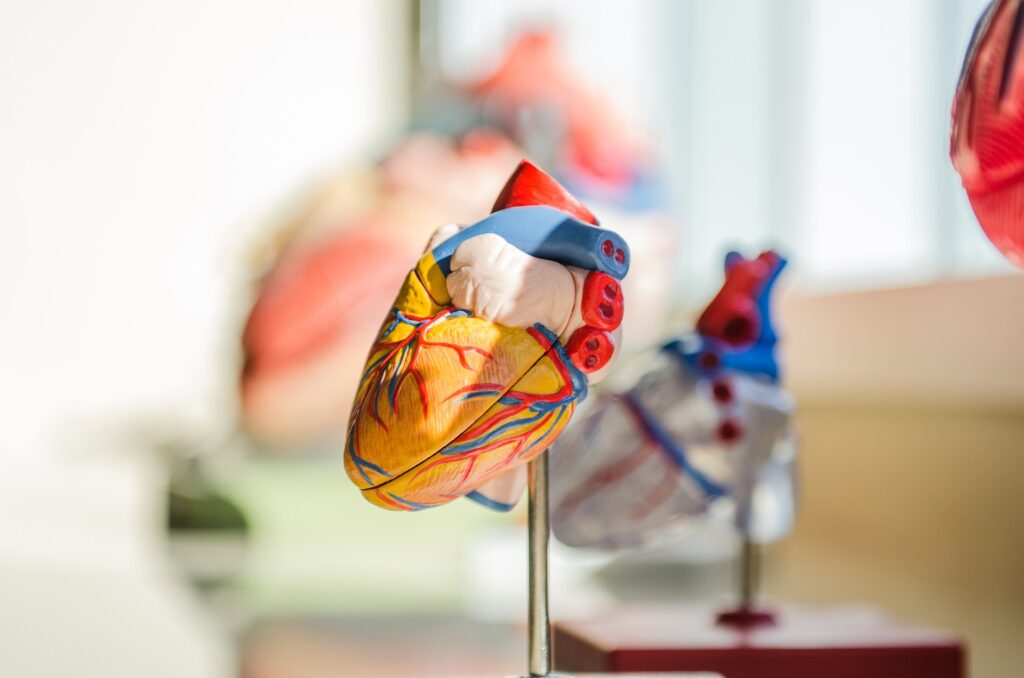Myocardial infarction (MI) encompasses a spectrum of clinical presentations, each characterized by unique electrocardiographic (ECG) changes and involvement of specific coronary arteries. Understanding the correlation between ECG findings, myocardial territory affected, and the occluded coronary vessel is paramount for accurate diagnosis and management. Below, we explore the types of MI, including anterior wall MI, inferior wall MI, posterior wall MI, and their associated ECG changes and implicated coronary arteries.

1. Anterior Wall Myocardial Infarction (AWMI)
ECG Changes:
- ST-Segment Elevation: Pronounced ST-segment elevation (>1 mm) in the precordial leads (V1-V4), typically seen in leads V2-V3.
- Reciprocal Changes: ST-segment depression in the inferior leads (II, III, aVF) or lateral leads (I, aVL).
- Pathological Q-Waves: Development of Q-waves in the anterior leads (V1-V4) post-infarction.
Implicated Vessel: Left Anterior Descending (LAD) coronary artery.

2. Inferior Wall Myocardial Infarction (IWMI)
ECG Changes:
- ST-Segment Elevation: ST-segment elevation in the inferior leads (II, III, aVF).
- Reciprocal Changes: ST-segment depression in the anterior leads (V1-V3) or lateral leads (I, aVL).
- Possible Posterior MI: Presence of ST-segment depression in leads V1-V3 suggestive of posterior MI extension.
Implicated Vessel: Right Coronary Artery (RCA) or Left Circumflex (LCx) artery.
3. Posterior Wall Myocardial Infarction (PWMI)
ECG Changes:
- ST-Segment Depression: ST-segment depression in the posterior leads (V1-V3) with prominent R-waves, often accompanied by tall T-waves.
- Possible Reciprocal Changes: ST-segment elevation in the anterior leads (V1-V3).
Implicated Vessel: Right Coronary Artery (RCA) or Left Circumflex (LCx) artery.
4. Lateral Wall Myocardial Infarction
ECG Changes:
- ST-Segment Elevation: ST-segment elevation in lateral leads (I, aVL, V5-V6).
- Reciprocal Changes: ST-segment depression in the inferior leads (II, III, aVF) or anterior leads (V1-V3).
Implicated Vessel: Left Circumflex (LCx) artery.
5. Right Ventricular Myocardial Infarction (RVMI)
ECG Changes:
- ST-Segment Elevation: ST-segment elevation in the right precordial leads (V4R-V6R).
- Reciprocal Changes: ST-segment depression in the lateral leads (I, aVL, V5-V6) or inferior leads (II, III, aVF).
Implicated Vessel: Right Coronary Artery (RCA).
Treatment and Management of Myocardial Infarction
Myocardial infarction, commonly known as a heart attack, is a life-threatening medical emergency that requires immediate and effective treatment to minimize damage to the heart muscle and improve outcomes. From rapid recognition of symptoms to the administration of specific medications and interventions, every step in the treatment and management process plays a crucial role in saving lives. Here’s a detailed look at the specific drugs, interventions, and management strategies commonly used in the treatment of myocardial infarction:
1. Recognition of Symptoms
The first step in treating myocardial infarction is recognizing the symptoms and seeking immediate medical attention. Common symptoms include chest pain or discomfort, shortness of breath, nausea, lightheadedness, and pain or discomfort in the arms, back, neck, or jaw. It’s essential not to ignore these warning signs and seek medical help promptly.
2. Emergency Medical Response
Upon recognizing the symptoms of a heart attack, it is vital to call emergency services immediately. Emergency medical responders can provide lifesaving interventions, including oxygen therapy and administration of specific medications.
3. Hospital Treatment
Once at the hospital, patients suspected of having a heart attack undergo a series of diagnostic tests, including electrocardiography (ECG or EKG) and blood tests to measure cardiac enzymes. These tests help confirm the diagnosis of myocardial infarction and determine the extent of heart damage.
4. Reperfusion Therapy
Reperfusion therapy aims to restore blood flow to the affected area of the heart, reducing further damage and improving outcomes. This can be achieved through two primary methods:
a. Thrombolytic Therapy: Thrombolytic drugs, such as alteplase (tPA), reteplase, and tenecteplase, are administered intravenously to dissolve the blood clot causing the heart attack, restoring blood flow to the heart muscle.
b. Percutaneous Coronary Intervention (PCI): PCI involves threading a catheter with a balloon attached through a blood vessel to the blocked coronary artery. The balloon is inflated to open the artery, and a stent is inserted to keep it propped open, allowing blood to flow freely.
5. Medications
In addition to reperfusion therapy, patients with myocardial infarction may receive various medications to manage symptoms, reduce complications, and improve long-term outcomes. These medications may include:
a. Aspirin: Given in a loading dose of 150-300 mg, aspirin helps prevent blood clots from forming and reduces the risk of further heart attacks.
b. Clopidogrel (Plavix): Often given in a loading dose of 300-600 mg, clopidogrel is another antiplatelet agent that helps prevent blood clots.
c. Morphine: Morphine sulfate may be administered to relieve chest pain and reduce anxiety in patients with myocardial infarction.
d. Beta-Blockers (e.g., Metoprolol): These medications help lower blood pressure and reduce the workload on the heart, protecting against further damage.
e. ACE Inhibitors (e.g., Lisinopril) or ARBs (e.g., Losartan): These drugs help relax blood vessels, improve blood flow, and reduce strain on the heart.
f. Statins (e.g., Atorvastatin): Given in a loading dose of 80 mg, statin medications help lower cholesterol levels and reduce the risk of future cardiovascular events.
6. Oxygen Therapy
Oxygen therapy may be provided to patients with myocardial infarction to improve oxygenation and relieve symptoms of hypoxia.
7. Cardiac Rehabilitation and Lifestyle Modifications
After the acute phase of treatment, patients recovering from myocardial infarction are often referred to cardiac rehabilitation programs. These programs offer supervised exercise, education, and support to help patients regain strength, improve cardiovascular health, and adopt heart-healthy lifestyle habits.

Pingback: Sildenafil - What Viagra is made of - Modern Health
Pingback: Hypothyroidism : Cuases, Symptoms and Treatment - Modern Health
Pingback: Cannonball Metastasis - Modern Health
Pingback: Albuterol Inhalation ,Oral – Uses and Side Effects - Modern Health
Pingback: End Organ Damage in Hypertension - cause and treatment - Modern HealthMe